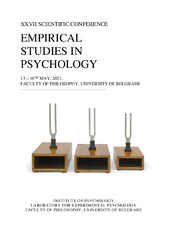Prikaz osnovnih podataka o dokumentu
Leisure time in adolescence: behavioural patterns and adolescents’ groups
| dc.creator | Blažanin, Barbara | |
| dc.creator | Stepanović Ilić, Ivana | |
| dc.creator | Krstić, Ksenija | |
| dc.date.accessioned | 2023-05-08T08:05:50Z | |
| dc.date.available | 2023-05-08T08:05:50Z | |
| dc.date.issued | 2021 | |
| dc.identifier.isbn | 978-86-6427-166-0 | |
| dc.identifier.uri | http://reff.f.bg.ac.rs/handle/123456789/4412 | |
| dc.description.abstract | Spare time is a significant social context that may promote adolescents’ positive development and prevent risk behaviour. This research is aimed to identify patterns of adolescents' behaviour during spare time and groups of adolescents clustered by similar preferences related to their leisure activities and interests. The sample consisted of 1349 first and third grade secondary school students (56% female, 51% first grade) from 10 different cities in Serbia. The questionnaire was distributed to students in schools and included groups of closed-type questions, mainly with 5-point scale, related to: hobbies, different themes/shows in media, listening to music, going out, attending cultural and sports events, activities on Internet and social network usage. The Principal axis factoring with Varimax rotation was applied on 49 items and based on the extracted factors a Hierarchical cluster analysis (Ward’s method) was conducted consequently. The KMO and Bartlett’s test of sphericity verified the sampling adequacy (KMO = .822 χ 2 (1176) = 18712, p = .001). The ten factors solution explaining 54.5% of variance was chosen (according to eigenvalues, scree-plot and interpretability) including following factors: IT, Pop culture, Reflective & Complex music, Intense & rebellious music, Science and culture, Politics, Going out, Sports, Films and TV shows, Online communication. Obtained factor composite scores were generated and used in following cluster analysis, which revealed 5 groups of adolescents. The first Up to date cluster (13%) includes adolescents interested in science, culture and politics who prefer Reflective & Complex music. In the second cluster (21%) are adolescents prone to Mainstream culture following pop culture and watching films and TV shows. Sport fans are in the third cluster (25%). IT "nerds" is the fourth group (11%) which practices IT and listens to Intense & Rebellious music. The fifth and the largest group of adolescents (30%) are Typical adolescents, who do and like everything young people prefer, but nothing in particular. They follow pop culture, more than politics or science, prefer pop music than other genres, go out, watch films and series, and spend time on online communication. Similar to previous studies, fun, unstructured and passive activities are the most prominent in the leisure time of adolescents. The results are discussed in the light of possible consequences on adolescents’ development and wellbeing. | sr |
| dc.language.iso | en | sr |
| dc.publisher | Institut za psihologiju, Filozofski fakultet u Beogradu | sr |
| dc.publisher | Laboratorija za eksperimentalnu psihologiju, Filozofski fakultet u Beogradu | sr |
| dc.relation | info:eu-repo/grantAgreement/MESTD/inst-2020/200163/RS// | sr |
| dc.rights | openAccess | sr |
| dc.rights.uri | https://creativecommons.org/licenses/by/4.0/ | |
| dc.source | BOOK OF ABSTRACTS OF THE XXVII SCIENTIFIC CONFERENCE Empirical Studies in Psychology | sr |
| dc.subject | leisure time | sr |
| dc.subject | adolescents | sr |
| dc.subject | behavioural patterns | sr |
| dc.subject | clusters | sr |
| dc.title | Leisure time in adolescence: behavioural patterns and adolescents’ groups | sr |
| dc.type | conferenceObject | sr |
| dc.rights.license | BY | sr |
| dc.citation.epage | 100 | |
| dc.citation.spage | 100 | |
| dc.citation.volume | 27 | |
| dc.identifier.fulltext | http://reff.f.bg.ac.rs/bitstream/id/10860/bitstream_10860.pdf | |
| dc.identifier.rcub | https://hdl.handle.net/21.15107/rcub_reff_4412 | |
| dc.type.version | publishedVersion | sr |

